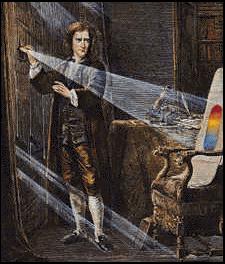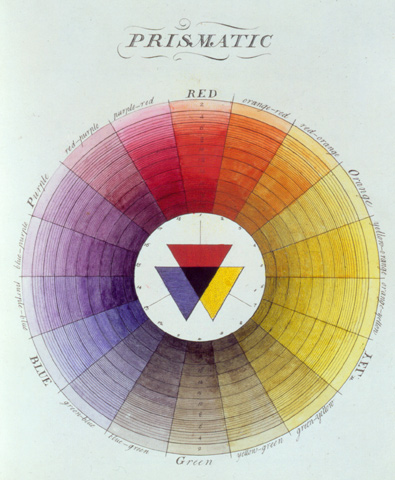

A color wheel is a way of representing the visible spectrum in a circular form, with colors arranged in sequence around the circumference in order of spectral frequency.
The wheel allows us to to form color relationships between the hues.
The wheel also allows us to regard each hue as a separate color entity.
The earliest concept of color was that of white and black: lightness and darkness. The first chromatic concept to be identified was red. Primitive man responded to its powerful associations with blood, fire, and the sun. The next hues were identified in this order: yellow, green, blue, orange, and brown.
Aristotle (384-322 B.C.) believed that all colors were the result of mixtures between light and dark as based on observations of color in the course of a day. The white light of noon becomes tinged with yellow, and changes gradually to orange, and then to red. After sunset, this evening red becomes a purple violet, changing to a night sky which appears as dark blue. In between, green light can sometimes be seen. (It is unlikely that many have observed a green glow at sunset, but there are numerous photographs documenting this). These basic hues are placed between white and black in a linear fashion.

The Newton Color Circle

![]()
Harris
The scientist and naturalist Moses Harris created
the first color wheel to classify red, blue and yellow as the three primary
colors.
This was in 1766, just a hundred years after
Newton’s discovery.
Moses worked with pigments rather than lights
following a discovery by a French painter that all hues could be reduced to
mixtures of red, yellow and blue pigments. He developed and illustrated his
theory.

Picture Above – Moses Harris, the first color wheel
to classify red, blue and yellow as the three primary colors.
In the centre, the three pigment primaries
(primitives) red, yellow and blue from which all colors could theoretically be
mixed. He then derived the secondary (compound) hues orange, purple, and green.
The mixture of primitives and compounds provided two intermediate stages. This
created 18 colors; these were then graded into shades (darker values, which he
created by optically mixing more closely placed black lines) and tints (lighter
values, normally created by adding white, but he showed wider spacing between
the black lines).
His classification theory was widely accepted by
artists by the mid 19th Century.
Goethe
Newton's color circle, with seven colors subtending unequal angles, did not exhibit the symmetry and complementarity that Goethe regarded as essential characteristics of color. For Newton, only spectral colors could count as fundamental. By contrast, Goethe's more empirical approach led him to recognize the essential role of (nonspectral) magenta in a complete color circle, a role that it still has in all modern color systems. Artisans such as painters, dyers, and tanners, who had to deal practically with color, generally felt much more attracted to Goethe's color circle than to Newton's.
Goethe’s diagrams in the first plate of Zür Farbenlehre (Theory of Colors) include a colorwheel and diagrams of distorted color perception. The bottom landscape is how a scene would look to someone who was blue-yellow color blind.
Today
Artists work in one or the other of two color modes: additive or subtractive. There are three color wheels that are significant for our use today: the additive color circle, the subtractive process color circle, and the traditional color circle. All of these color circles are significant for artists in different applications.
As artists or designers, we are primarily working and thinking in the subtractive color mode. The traditional color circle is the most functional one for artists' materials such as pigments, dyes, and inks, since it applies to the laws of color subtraction. Since most artists use at least one type of traditional media; a traditional 12-hue color circle is the rational choice for reference.
For graphic designers, the subtractive process color circle based on the primaries of CMY is the proper reference for printed color.
The additive color circle is significant for color/light processes such as photography, the RGB mode in computer color, and color lighting. The additive circle should not be used as a reference for the printing process or traditional art materials.